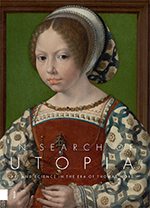At a time when the largest municipal museums in Belgium, both Antwerp and Brussels, are undergoing repairs and are withdrawn from major exhibitions, M, the Leuven Museum, has stepped up with important early modern initiatives. Readers of this Newsletter were already informed of Koenraad Jonckheere’s Michiel Coxcie exhibition (2013); now they can thank a large team under the inspired supervision of Jan Van der Stock of Leuven University for this major celebration of the 500th anniversary of the publication of Thomas More’s Utopia in the same city.
This wide-ranging exhibition encompasses many approaches to the larger topic sparked by More’s everlasting little publication; its impressive loans are accompanied by stimulating, but widely diverse essays. This reviewer is reminded of another exhibition, also prompted in the wake of new European discoveries, The Age of the Marvelous (1991), both for stimulation and for sheer variety.
Some topics seem forced in relation to the whole and are labeled “Beyond Utopia.” Particularly distinct are the besloten hofjes, the elaborate, mixed-media floral altarpiece assemblages of ideal enclosed gardens, made for meditation of nuns and recovered from monasteries in nearby Mechelen (essay by Barbara Baert, “A Utopian and Mystical Sanctuary,” 49-53; nos. 32-34, introduced by Lieve Watteuw). The Garden of Eden as earthly Paradise also forms an early exhibition segment (nos. 26-31). Its complement, a City of God miniature from Paris (no. 35), does indeed fully imagine a late medieval Utopia of faith. Other images of ideal sites include Fountains of Youth in the form of a tapestry (no. 20), a multi-sheet Beham woodcut (no. 21), and a ravishing Garden of Love from a Bruges Roman de la Rose ms (no. 23). Certainly relevant are their inverse, the Boschian hellscapes of dystopia, introduced by Daan van Heesch (nos. 36-41). Paul Vandenbroeck’s essay (“Erotic Utopia,” 41-47) engages both concepts through Bosch’s Garden of Delights (whose Brussels tapestry copy, rarely on view, is no. 22). Seemingly out of place again is the garden gathering of the Antwerp archery guild by the Master of Frankfurt (Antwerp, Koninklijk Museum; no. 24), another major loan, as is Herri met de Bles’s Eden tondo (1540s; Amsterdam, Rijksmuseum, no. 29).
More directly tied to the discovery theme of More himself, several essays and sections explore new lands under the heading “Beyond the Horizon.” The essay of Hans Cools (21-28) addresses “Europe-America-Utopia,” and a large section of loan objects, “Beyond the Horizon,” is framed by Emmanuelle Vagnon (“Terra Incognita,” 55-61; nos. 42-58). These objects include: mappaemundi and world maps (nos. 42-45); representations of explorations and exotic peoples (nos. 46, 49, 50-51, 54, 56, 58); and magnificent figurated maps of newly discovered regions (nos. 44, 52-53, 55; now consult Surekha Davies, Renaissance Ethnography and the Invention of the Human. New Worlds, Maps and Monsters, Cambridge, 2016). While somewhat tangential to the imaginary world of More’s book, astronomical and navigational instruments, some of them from Leuven itself (introduced by Koenraad van Cleempoel, 63-69), plus sky maps and visual measures of time conclude the installation (nos. 60-77) as “Holding the Universe.” Several other loans deserve high praise among these instruments and maps: Heemskerck’s portrait of Gemma Frisius, the celebrated geographer (ca. 1543; Rotterdam, Boijmans; no. 59); Gossart’s Princess Dorothea of Denmark with her small, inverted armillary sphere (ca. 1530; London, National Gallery, no. 64); plus a marvelous Spanish vision of Chaos, close to Fernando Gallego (Tucson, University of Arizona; no. 70). Six of Simon Bening’s exquisite images of the labors of the months from the Hennessey Hours (ca. 1530, no. 73) enrich this section on Time.
The actual Christian humanism of Erasmus and More forms the essential first part of the exhibition, and its context is discussed by Jan Papy (“Thomas More, Utopia and Leuven,” 31-38; nos. 1-6, 13-18; plus editions of the book, by Marcus de Schepper, nos. 7-12). Here some very important loans appear: a unique surviving woodcut city panorama of Leuven from the Royal Library (no. 2) and the large Rowland Lackey copy of Holbein’s lost Family of Thomas More (1593; London, National Portrait Gallery; no. 5). Massys’s portraits of the humanist circle further dazzle: Erasmus (1517; Royal Collection, no. 13; plus the studio replicas from Rome and Antwerp, nos. 14A-14B); Pieter Gillis and his Wife (Oldenburg, Landesmuseum; no. 15, which I still believe is the second wife of 1526 rather than the first wife of ca. 1514, as per the catalogue); and the imposing Scholar (ca. 1522-27; Frankfurt, Staedel, no. 16). Rounding off this all-star case is Dürer’s Berlin drawing, often identified as Sebastian Brant (no. 17), from his 1520-21 trip to the Netherlands.
One can question, as with Age of the Marvelous, whether the whole of this display is greater than the dazzling but diverse sum of its parts. Certainly More and his book provide a marvelous context at the outset. And European representations of real and fictional figures from the other continents is a meaningful highlight that underscores both knowledge (and its limits) as well as imagination in the early era of explorations. Whether alternate worlds of Paradise or Hell needed a place here, let alone the hofjes, will evoke different responses from visitors. But the sheer ambition of this Leuven exhibition and its impressive loan objects in wide-ranging, varied media combine with reliable research on items both familiar and novel. Taken together, the items of In Search of Utopia become not only memorable but also seminal, bringing artworks into dialogue with scholarship in numerous other disciplines.
Larry Silver
University of Pennsylvania
